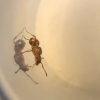
Here is a picture of what I mean.
Sent from my iPhone using Tapatalk


From the looks of it it seems that the ants have majors and minors, and if not that then just different sized workers like Veromessor pergandei. Either this or you have some leftover nanitics, or your ants are varying how much they feed their larvae for hibernation/diapause.
The ants go marching.
Currently keeping:
Myrmica don't seem to be polygynous, the size variation is just likely due to nanitics remaining. This difference in size occurs in a lot of ants, where worker size increases as the colony's population grows. Eventually they should all reach a similar size once full-sized workers are produced.
"Float like a butterfly sting like a bee, his eyes can't hit what the eyes can't see."
- Muhammad Ali
Check out my shop and Formica journal! Discord user is bmb1bee if you'd like to chat.
Also check out my YouTube channel: @bmb1bee
Full sized workers might not appear for a while, so worker size may vary quite a bit as the colony collects more food over time. Worker size kind of depends on the nutrients they get from what I've heard and read.
"Float like a butterfly sting like a bee, his eyes can't hit what the eyes can't see."
- Muhammad Ali
Check out my shop and Formica journal! Discord user is bmb1bee if you'd like to chat.
Also check out my YouTube channel: @bmb1bee
0 members, 1 guests, 0 anonymous users